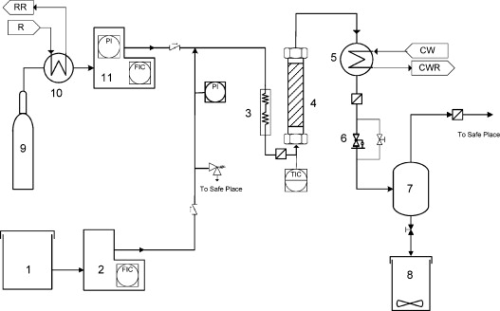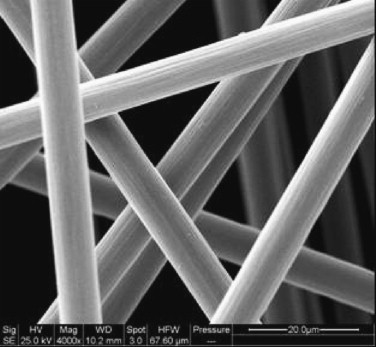


Disposing of carbon fibre composite will become a big issue as today’s low-weight carbon fibre reinforced plastic (CFRP) structures reach the ends of their service lives. This is clear given that, globally, over 27 000 tonnes of carbon fibre tow are currently being produced each year. Grinding up the end-of-life material and sending it to landfill or incinerating it, as happens with low-value glass reinforced plastic (GRP), has little appeal due to the non-degradability of carbon thermosets and the health and safety risks they pose.
Add to this the fact that long-fibre, high-grade carbon is a valuable commodity, costing upwards of £10 000 per ton when new, and it would make more sense to recover and recycle this if means could be found that offered competitively priced material having minimally impaired mechanical properties and good surface chemistry.
This poses the question of how to strip away the epoxy resin from fibres in such a way as to leave most of the original fibre properties undiminished. There are already some answers. Reinforced Plastics has previously reported on the method of pyrolysis, in which the epoxy is thermally degraded – in essence burned away in a reduced-oxygen combustion process. This technology is now being applied commercially, notably by UK recycler Milled Carbon. There are indications that microwave radiation can assist this process, enhancing the material recycling rate. Then there is the fluidised bed method, in which pre-fragmented waste material is ‘fluidised’ by having a high-temperature (around 550°C) fluid or gas passed through it from beneath in the presence of air, the ensuing pyrolysis and oxidation resulting in progressive separation of its components. These methods can, however, result in fibre shortening, some degradation of fibre properties, or both.
Now, though, researchers at the UK’s University of Nottingham have raised hopes that a new system they have demonstrated at small scale will facilitate the recovery, in near-virgin condition, of long high-modulus fibres that can be re-used in significant structures. The answer, according to a group led by Dr Steve Pickering in the university’s Faculty of Engineering, is to chemically dissolve the epoxy matrix away.
In itself, this is not a new idea and other researchers have tried reagents ranging from powerful organic solvents to nitric acid, but most of these are aggressive and sometimes toxic chemicals. The Nottingham team has been able to identify a solvent that is both manageable and effective, leaving the stripped fibres with nearly all the strength and stiffness they originally had. Its method can also recover useful chemicals from the epoxy resin whereas, in the pyrolysis and fluidised bed methods, there is little or no such recovery and the matrix is generally burned as fuel to help drive the process.
‘Solvents on steroids’
The Nottingham team’s breakthrough has been to exploit the dissolving power of supercritical fluids, a class of solvent that has proved effective in other industries.
The Nottingham researchers investigated supercritical water, carbon dioxide and a number of organic solvents including ethanol, methanol and acetone, before alighting on propanol, an affordable short-chain alcohol that is reasonably benign in its normal state. Alcohols are interesting because they require only moderate pressure (2-7 MPa), albeit with high temperature (200-450°C), to go supercritical. This makes them more convenient to use than, say, water, which requires a pressure of 22.1 MPa and temperature of 374°C to reach its critical point. Ethanol and methanol are effective in dissolving polyester resin in glass fibre composite, but do not work well with epoxy. Propanol, on the other hand, can successfully break down epoxy.
When the team tested the effect of supercritical propanol on small samples of CFRP waste in both batch and semi-continuous reactors, the results were gratifying. The epoxy matrix was dissolved, leaving clean, unbroken carbon fibres. Tests carried out on the fibres showed that these were almost as good as new, retaining a high proportion of their original strength and stiffness (up to 99% in some cases) and having a surface chemistry conducive to bonding with new matrix material. Fibres were left without any apparent damage even after total resin elimination. One indication of this was that the weight of recovered filaments matched that of the original fibres. The resin component decomposes into potentially useful lower molecular weight hydrocarbons, principally phenol.
In continuing work to optimise the process, the Nottingham experimenters concluded that temperature is the most critical variable, followed by pressure and flow conditions. They found that the temperature required, and hence process costs, can be reduced by using an alkali catalyst. Applying a semi-continuous flow system along with a catalyst accelerated the depolymerisation process. One test series established that around 98% by weight of resin was removed with a flow of 1.1 kg of alcohol per 1 kg of fibre/minute when the temperature was 350°C and potassium hydroxide (KOH) catalyst was used. Removal decreased to 96.5% if the temperature was lowered to 275°C.
Commenting on the team’s findings, Steve Pickering told Reinforced Plastics: “Although we have so far demonstrated this technique only in the laboratory at test-tube scale, we think the initial results are very promising. Using supercritical propanol has many potential benefits. The reaction happens at manageable temperature and pressure, it recovers clean fibres in a condition that is close to virgin, and it also breaks down the matrix into usable chemicals. We now hope to scale up the process into something that can deliver kilograms of valuable fibre rather than just a few grams.”
There are other aspects to be explored too. It is too early to say, for instance, whether the process, so far tried on polyacrylonitrile (PAN) carbon fibres, will be equally effective on pitch fibres, though Pickering sees no reason why it should not be. It has been tested on cured and uncured material (about 40% of long-fibre pre-impregnated material comprises uncured manufacturing offcuts) and proved successful on both, but it has not yet been tested against samples of sandwich or bonded structure.
It is known that fluidised bed, the other major recycling process that the Nottingham researchers have investigated, works well with mixed-materials, so it will be interesting to see, thinks Pickering, how the supercritical fluid answer compares. He would also like to find out how the process, or derivatives of it, measure up against other resin chemistries including vinyl esters, phenolics, bismaleimides and thermoplastics. Removing minority components such as bulking fillers plus alumina trihydrate (ATH) and other fire-resistant additives might require further separation processes.
Collaborative programme
Work carried out so far has been funded under the collaborative HIgh Value Composite Materials from REcycled CARbon Fibre (HIRECAR) programme, aimed at finding ways to recycle carbon composite materials into car manufacture and other applications. The three-year project, which ended last year, was led by Nottingham University and included material supplier the Advanced Composites Group (ACG), Dow Automotive, the Ford Motor Company, fibre processing company Technical Fibre Products and carbon fibre producer Toho Tenax GmbH. Research is now entering another phase with a follow-on programme called AFRECAR (AFfordable REcycled CARbon Fibres). Nottingham University, again in the lead, is collaborating with ACG, Ford, Technical Fibre Products and Toho Tenax, plus recycler Milled Carbon and aircraft manufacturer Boeing.
|
A supercritical fluid is one that has been taken, with a combination of temperature and pressure, beyond a thermodynamically critical point at which it changes phase. This can be illustrated by reference to water. Everyone is familiar with the phase change that occurs when water is heated to 100°C and becomes steam. But if the water, instead of being heated normally, is heated under pressure in a confined space, there comes a point (the critical point), at which the phase boundary between the water and the steam disappears. The container contents are then a homogenous supercritical fluid. Actually, this is more like a gas than a fluid or vapour. Supercritical fluids can diffuse through a solid like a gas, greatly enhancing solvation capability. Moreover, not only is the supercritical fluid like a ‘normal solvent on steroids,’ but its properties can be fine-tuned around the critical point with small adjustments to temperature, pressure and flow. So precise can be the adjustment, that in some cases particular molecule types can be targeted. The phenomenon of supercriticality is in everyday use, for instance in the extraction of caffeine from coffee beans, of stains from clothes in dry cleaning, of active pharmaceutical agents from plants, and of flavour from hops when making beer. Substances such as water and carbon dioxide can be used like organic solvents when in their supercritical state. Dissolved material can be precipitated out again by de-pressurising the reaction vessel and evaporating the resulting gas. |
The latter’s inclusion is particularly significant in view of the fact that composites account for a growing proportion of aircraft structure, around 50% by weight in the latest generation (B787, A350 XWB, JSF etc) and predicted to rise still further. When thousands of largely composite aircraft reach the ends of their 25-30 year service lives, end-of-life disposal will become a serious problem if effective recycling systems and supply chains are not in place by then.
“This project will provide key technology contributions to eventual recycling solutions,” comments Billy Glover, managing director environmental strategy for Boeing Commercial Airplanes. “The Boeing commitment to the environment is reflected in our proactive involvement in composite recycling. We continue to work with industry leading technology developers and recyclers towards environmentally progressive recycling for aircraft production and end-of-life.”
The Nottingham team includes key researchers Professor Nick Warrior, Dr Ed Lester and Dr Steve Pickering, the latter as team leader. The £900 000 programme is being funded by the Technology Strategy Board, which is sponsored by the UK government‘s Department for Innovation, Universities and Skills (DIUS).
AFRECAR aims not only to establish that the so-far laboratory-scale process can successfully be scaled up to something able to deliver worthwhile amounts of recycled carbon, but also to find and develop uses for that carbon. Additionally, it will explore the economics of recovering phenol and other hydrocarbons from the epoxy and whether these can be re-used as chemical feedstock.
Uses
Finding and cultivating markets for recyclates is key to building a viable recycling solution overall. According to Professor Nick Warrior, HIRECAR and related programmes have focused largely on the use of recycled carbon fibre in bulk moulding compound (BMC) for smaller, non load-bearing components, and in sheet moulding compound (SMC) where carbon fibre is rolled together with sheets of polymer. BMC and SMC are widely used by the automotive industry. Recycled carbon fibre is also being tested for use in tyres, industrial injection moulds and sporting goods such as skateboards. Aero equipment suppliers are looking to exploit it for such items as aircraft baggage bins and galley carts. Use in vehicle brakes is the focus of the UK government-funded ReBrake programme, in which Milled Carbon is a key participant. Flocked fibre can be used for conductive substrates, filter media and decorative interiors. Short fibres can enhance the strength and durability of concrete used in construction.
The big apparent advantage of the supercritical fluid recovery method is that it can retrieve the most valuable form of carbon fibres suitable for higher-grade applications including substantial engineered structures such as vehicle floor pans and secondary aerostructures. This is because of its ability to recover in impressive condition long fibres that can subsequently be aligned, a key factor in making recycled fibres suitable for load-bearing applications.
“If the material can be spun into continuous yarn with properties and costs competitive with those of new carbon fibres, it will expand the application of composites in vehicles and other structures where weight reduction is important,” according to Dr Ebby Shahidi, technical director of Advanced Composites Group. “Typical applications would include light body panels, chassis etc in the automotive sector, plus numerous components in marine, aerospace and other industries.”
A UK Technology Innovation Programme, FibreCycle, is one recycling initiative that is focusing on the conversion of recycled carbon fibre into spun yarn. Steve Pickering anticipates that such yarns and tows will enable the production of prepreg-like materials having high fibre volume fractions and hence competitive strength and stiffness-to-weight properties. Technical Fibre Products, in particular, will be closely involved in this aspect of the work.
| Further information about the University of Nottingham's research can be found in the paper Chemical Recycling of Carbon Fibre Composites using Alcohols under Subcritical and Supercritical Conditions, Journal of Supercritical Fluids, Volume 46, Issue 1 (2008), pages 83-92, published by Elsevier. This article is available on ScienceDirect; www.sciencedirect.com. |
It appears the UK may have a world lead in researching this technology. Some work is believed to be taking place in Japan but details are unavailable, while US recycling specialist Adherent Technologies claims to have a similar process but, again, is coy about the details. Steve Pickering is optimistic about the prospects.
“The future looks promising,” he declares. “Industry will generate thousands of tons of carbon composite and it makes good environmental and economic sense for most of this to be recycled.”
In any case legislators, driven by the environmental imperative, will insist upon it. Being able to obtain a high-grade recycled product will make all the difference, greatly expanding the market for recyclate. It may also expand the market for carbon composites overall. Automotive manufacturers, for example, will be less concerned about adopting weight-saving composites in a legislative climate mandating that future vehicles will have to be up to 80% recyclable once they are confident that means exist to recycle them cleanly and efficiently. Composite interests around the world will undoubtedly be keeping a keen eye on AFRECAR progress.





